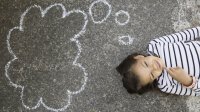Nobel Laureates Can Teach Kids to Persevere
Nobel Prize winners show kids the role of failure in learning and demonstrate that there is no single recipe for creativity.
Could a future Nobel laureate be sitting in your classroom today?
“Nobel laureates are not people from Mars,” says Carin Klaesson of the Nobel Museum in Stockholm. “They’re people. They’re people who are a little bit extraordinary when it comes to their persistence.”
Nobel Journeys, which tells the stories of 10 laureates from diverse disciplines and cultures, is a joint production of the Nobel Museum and EF Education First. (The book and accompanying lesson plans, aligned to Common Core State Standards, are available to teachers as free downloads.)
Tales of Grit
On the same day that Bob Dylan was announced as this year’s winner of the Nobel Prize in literature, I caught up with Klaesson by phone. What does she hope students and teachers will gain from exploring the short profiles of Albert Einstein, Malala Yousafzai, and other luminaries?
“Certainly the Nobel Prize is a glamorous thing,” she acknowledges, “but we want to emphasize that the road to the prize is not always so glorious. It has to do with hard work and grit. Failure is a way of learning and a step in the process of getting wiser. This a good thing to tell kids.”
Selecting 10 laureates to profile was a challenge, given that the Nobel committee has recognized more than 900 individuals since 1901. The featured stories are deliberately diverse, ranging from American novelist Ernest Hemingway to Polish scientist Marie Curie to Romanian Holocaust survivor Elie Wiesel.
“It doesn’t matter if you’re a man or a woman, or the color of your skin,” Klaesson says. “It is the ideas and the words that matter. That’s the Nobel idea.” Alfred Nobel’s own story, tracing his evolution from inventor of dynamite to global humanitarian, is also included.
What readers won’t find among these stories is a recipe for creativity. “The Nobel history shows us that there’s no such thing,” Klaesson points out. Nor do laureates develop their breakthrough ideas in isolation. “They’re not working in a bubble. Einstein had a vast correspondence with scientists all over the world. Even the writers, who are more lonely, produce work that is a reflection on the world, on other writers, on what they have read before.”
Cultivating Global Citizens
Another thread that connects the stories is the influence of travel and the importance of global citizenship. In her work as a curator at the Nobel Museum, Klaesson has had opportunities to meet recent laureates and to explore the treasure trove of artifacts donated by previous winners. “The idea comes across from all of them that this is one planet. If we’re going to cure disease, solve environmental challenges, or heal the wounds from wars, we need to do that as the human race,” she says. “Global citizenship is essential.”
Travel and exposure to new cultures challenged many of the laureates “to step outside their comfort zones, which gave them a new perspective on the world and their place in it,” adds Kate Berseth, executive vice president of EF Education First. “This is where they found the inspiration to accomplish amazing things and truly become global citizens.”
To nurture the same global citizenship in today’s students, Berseth encourages educators and parents “to expose students to new cultures, whether through a trip to a neighboring U.S. state, a historic tour of Europe, hosting a cultural exchange student, or even engaging with a new community at home.”
To help cultivate a new generation of global citizens, a nationwide scholarship competition is underway to send 20 U.S. students to Italy next summer to attend EF’s next Global Student Leader Summit.
At the summit, participants will put their problem-solving skills to work on a design challenge about the future of food. The top two student proposals selected by judges will be exhibited at the Nobel Museum—right alongside exhibits about Nobel laureates.
